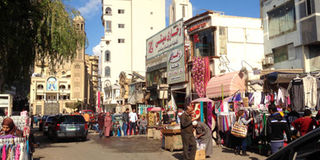From Kampala to Cairo and back

The Coptic Christian churches in the background reflect Egypt’s historic religious minority. Photo by Julia Burpee
What you need to know:
GRAND. Despite Egypt’s political instability, Cairo, its capital has sights that leave one awestruck as Julia Burpee writes.
I left Entebbe airport at 4.30am and by 9.30am, I was walking the streets of Cairo, Egypt’s capital and largest city. With a population of around 15 million compared to Kampala’s 1.5, the first thing that struck me about Cairo is how many people and cars there are in the city.
The one-hour drive from the airport to downtown is along multilane highways, giving the first glimpse of what’s clearly a middle-income country, at least as far as its impressive infrastructure, is concerned. In Egypt, few people ride motorcycles. I only saw a handful of them during my two-week vacation over Christmas. Locals rely on cars, matatus, big public buses, an underground subway and trains.
Travel may be more efficient in Egypt than in Uganda, but I spent my first day on foot anyway, wandering about 12km. I was pleased to stumble upon a variety of neighbourhoods. Like Kampala, Cairo has its Kololos, its upper-class areas riddled with embassies and Western restaurants, such as Zamalek, a posh island in the centre of the Nile and city. Cairo also has more modest areas and urban slums, where goats snack on sky-high piles of garbage and children walk without shoes.
Sights
A common sight in Cairo, though it always impressed me, is seeing cyclists wind through the city’s narrow streets balancing planks of wood with fresh pita on their heads. It may be North Africa, but Egyptians employ the same skills as their southern counterparts. Apart from carrying things on their heads, they also seem to find enterprising ways of earning money, like selling sunglasses outside the train station or food along the roadside.
In the predominantly Muslim country, the alcohol, cigarettes and nightclubs that are commonplace in Uganda are substituted with Egyptian tea (black tea with fresh mint), hookah and cafés clouded with shisha smoke. Tea is served in clear glass cups set on silver trays, a practice seen across Egypt; the delicate dishes and leisurely ritual of taking tea seems like something from another era against the backdrop of the country’s rapidly urbanising and bustling cities. My favourite dishes were Egyptian lentil soup and the 19th century staple, koshary, a mixture of rice, pasta, lentils, chickpeas, and tomato sauce topped with fried onions and garlic jus. I took a two-hour train ride north of Cairo to the coastal city of Alexandria, where I was regularly greeted by locals who used their limited English - Arabic is the only dominant language in Egypt - to say ‘welcome’, what’s your name?, or ‘thanks for visiting.’ The latter sentiment reflects the lack of tourists who visit the country nowadays, as one taxi driver explained.
While touring
The 2011 revolution and pursuant political instability hurt Egypt’s tourism industry and while the country is relatively safe now, I had no issues travelling there as a lone female, recovering its reputation appears to be challenging.
Hundreds of cruise ships are parked along the Nile in Luxor, a city 700km south of Cairo.
However, I saw many tourists at the city’s ancient temples, Luxor and Karnak, and in the Valley of the Kings, where royal tombs that were dug into the Thebes mountainside are open to the public. Nothing can prepare you for such sights; I entered King Tut’s fabled tomb and climbed 65-metres down into a stifling pyramid in Dahshur, near Cairo.
In Giza, the pyramids and vast desert leave you awestruck as they break the city skyline. The wealth of hieroglyphs carved into sandstone and all the stories they tell are equally enchanting.
Across the country, the ingenuity of humanity’s past is incomprehensibly well-preserved and will instil pride in any national. The only thing Egypt couldn’t offer, likely because I don’t speak Arabic, are people as cordial as Ugandans. I’ll cherish my trip there as well as the feeling of coming home to sunny Kampala, where people are as warm as the weather.
FOOD
I’m sorry to report that Egyptians don’t eat matooke, Ugandans’ mashed banana staple. The local fare is Middle Eastern: hummus, a chickpea and garlic dip, tabouleh, diced tomatoes, onions and parsley, falafels, called ta’amia, which are delicious deep-fried balls of beans or chickpeas, and pita bread are available everywhere.




